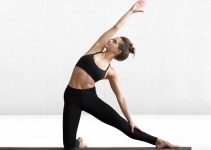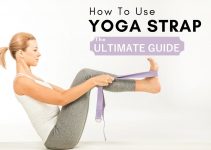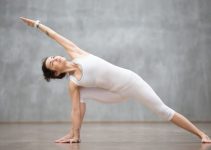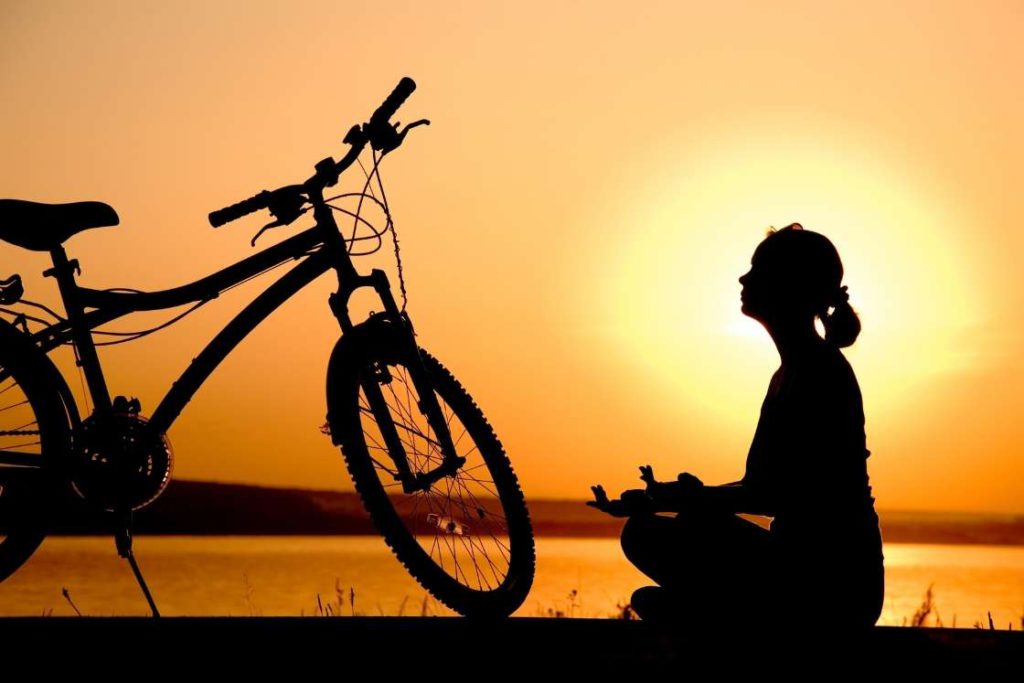
What do cyclists need the most? Strength, speed, and stamina. Yoga practices engage you into breathing through exercises that can help you as a cyclist, to develop all three basics.
Yoga poses as an exercise routine is used by many top cyclists of the world. It can help you build strength and endurance as well as makes you mentally and emotionally strong. Bradley Wiggins, the winner of the 2012 Tour De France cycling race had strengthened his core with Pilates, yoga, and exercise balls.
People are often too grasped by the notion of physical postures when it comes to yoga. However, yoga has two other quintessential parts. The body awareness through which you get into a posture, and the breathing before and during the hold period.
How does yoga complement cycling?
The body awareness which yoga gives will help cyclists stay more alert on the track, yet remain actively calm. Pranayama breathing exercises of yoga, on the other hand, will manage a cyclist’s need for energy. The physical posture itself will take care of the power; whilst all three combined will fetch stamina.
Yoga-warm up exercises let you activate your muscles pre-cycling period without draining too much of energy. It increases your stamina, hold you longer on the track in long race.
Cycling can often be too stressful on certain body parts; causing injury. Shoulders, back and hips, are the primary sufferers. Expert suggest yoga poses for the back can also act as a therapy to relieve back pain and heal injuries.
Yoga for Cycling Strength
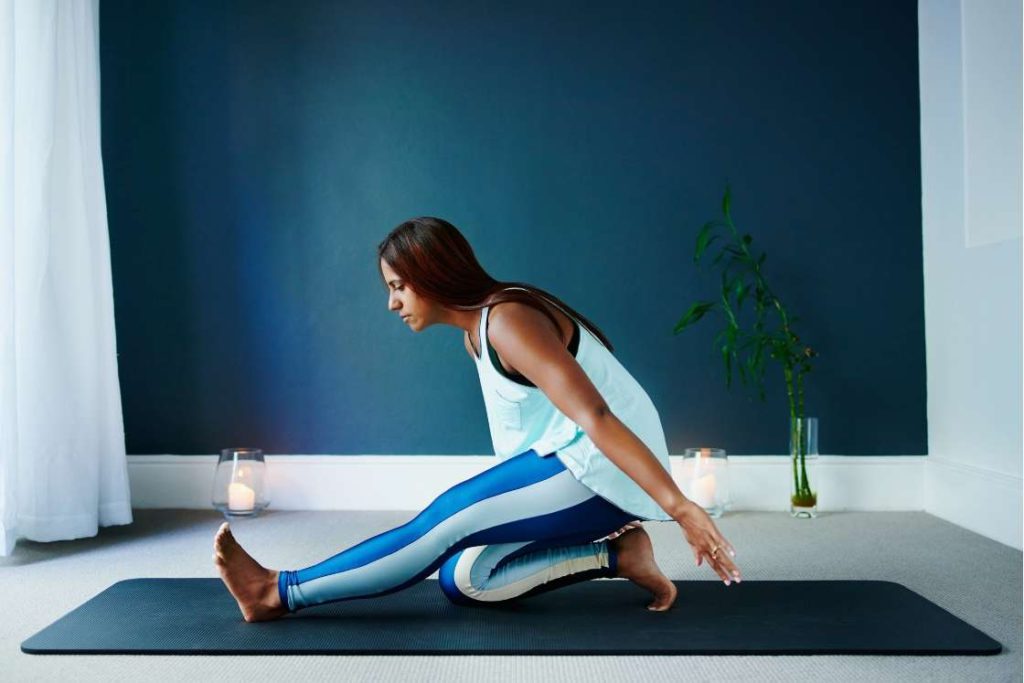
When it comes to cycling Strength, it implies the force with which you can pedal. This power is essentially generated by muscles and bone. Yoga has the potential to build new muscles around your bones, and improve the quality of your existing muscles.
The unique yoga poses, twists, holds, and stretches train the muscles for a unique range of motions. Yoga enables your muscles to bend, twist and stretch at extreme angles and perform perfectly under prolonged stress.
Finally, yoga exercises help your bones and joints learn ways to adapt to different movements and stress patterns. In short, regular yoga poses practice can help your muscles and bones churn out an explosive power.
These are 3 yoga poses you can perform to build up power for cycling.
1. Side Plank Pose (Vasisthasana)
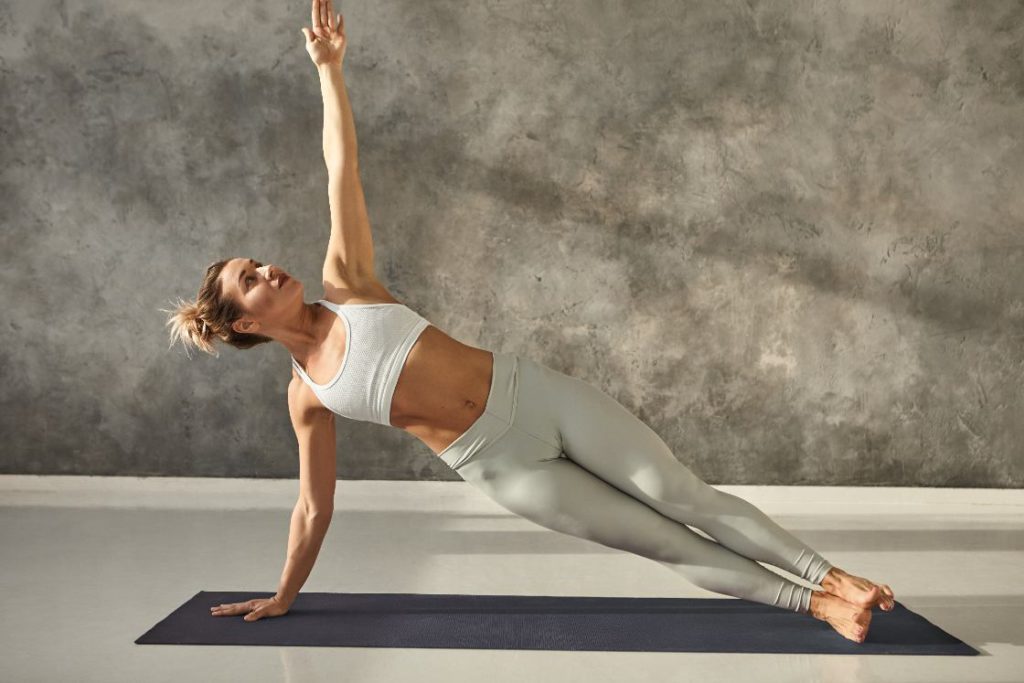
Strong core is essential for cyclists to avoid pain in the lower back after cycling. Plank poses are always a good idea for building core strength and power. Mostly because they engage your overall body muscles, in withstanding tension for a prolonged duration.
Side plank pose for cyclists will specifically develop your, back muscles, shoulders, side abs and glute muscles.
- Kneel down on your knees.
- Lean to your right, touch the ground with your right hand, and rest your body weight on your right hand.
- Stretch out both your legs, straight, to your left.
- Stack up both your feet, one over another.
- Make sure your wrist is exactly below your shoulder.
- Now push against the ground with your hands, activate your abs and glutes, and lift up your hip.
- Keep your body in one straight line. A slanting, from your head to toe, straight line.
- Breathe and hold the pose for 30 seconds.
- Repeat the pose on your other side
If the pose feels too easy, lift your left hand straight up, keeping in line with your right hand but in opposite direction. And lift your left leg parallel to the floor.
2. Reverse Plank Pose (Purvottanasana)
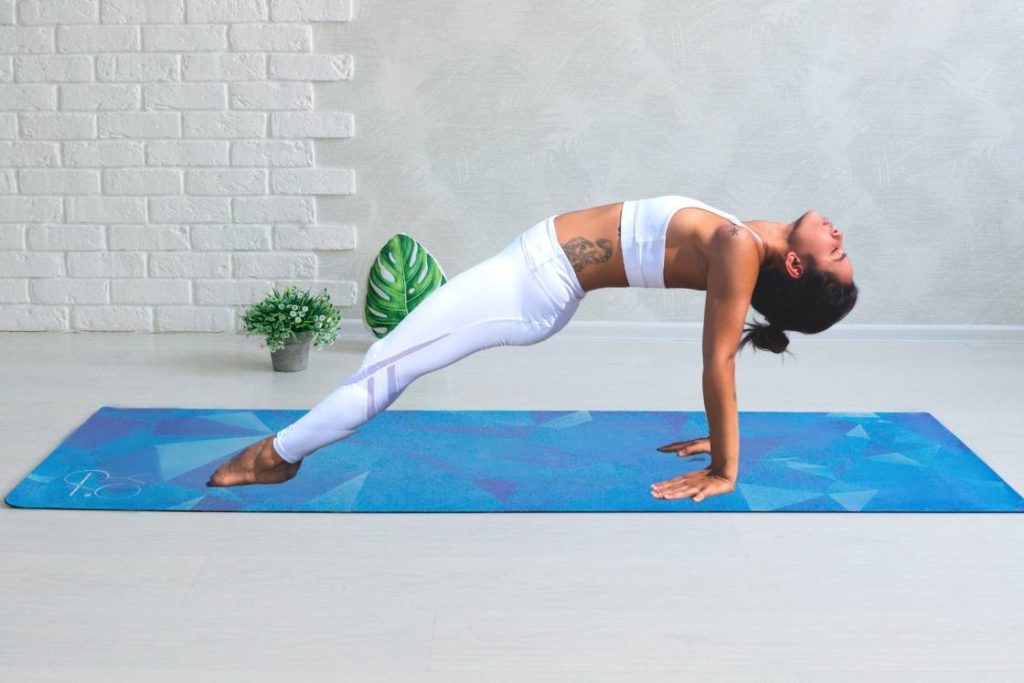
Reverse plank or upward plank pose will make your front abs, upper back, and spine powerful. As a cyclist, you will need your spine and upper back to flexible and strong enough to maintain your posture. The reverse plank will precisely help you at that.
- Sit in a staff position with your legs stretched straight.
- Recline back and rest your elbows on the ground, keeping them right below your shoulders.
- Now remove your elbow, and exactly in their position, place your palms.
- Now push against the ground and lift up your pelvis upward.
- Use your front abs, along with your hands, to lift your pelvis.
- Push upwards to have a slight upward bulge in your pelvis region.
- Keep your legs joined, and heels pressed against the ground.
- Keep your front abs, glutes and hamstrings active, to hold the pose.
- Breathe steadily, and hold the pose for 30 seconds
Reverse plank pose (Purvottanasana) can also act as a good stamina-building pose for cyclists if performed for a longer duration. However, the longer duration increases injury risk, so put a yoga block right under your tailbone for support and hold this pose for as long as 3-5 minutes.
3. Crow Pose (Bakasana)
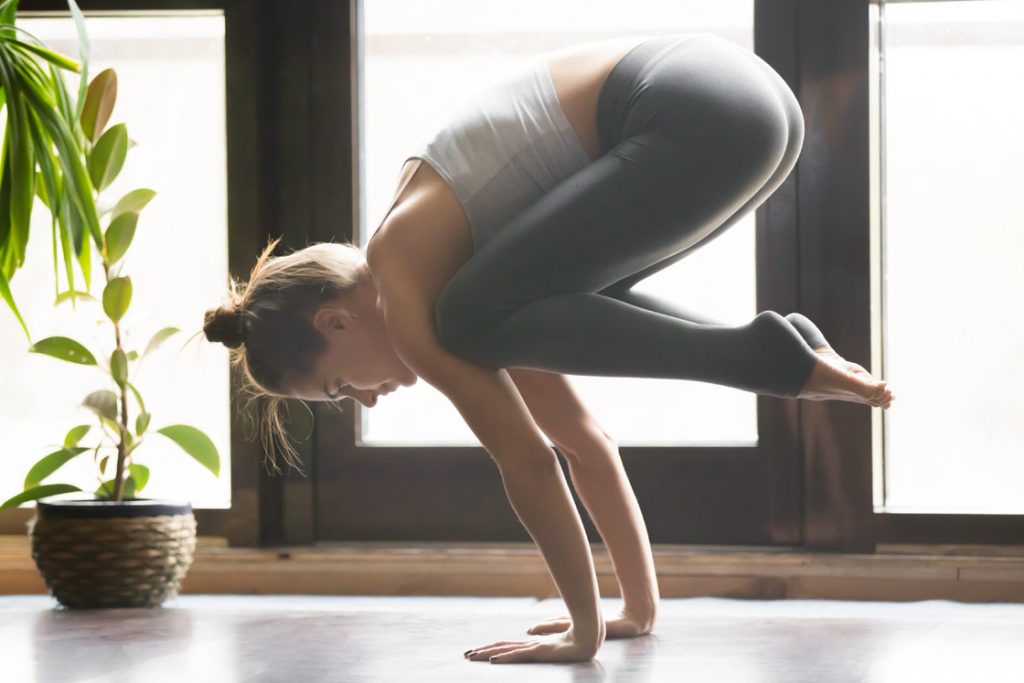
Crow pose can be a bit difficult to get the hang of, but it makes your upper body explosively powerful to hold cycling posture for a longer duration.
As your legs pedal with immense speed and power, your upper body holds your posture with stability, to counter the turbulent rocking motion set forth by your pedaling. This needs no small amount of upper body power. The crow pose will make your arms, shoulders, chest, and upper and lower back powerful.
- Sit in a full squat on a yoga block
- Drop down your hands and place them on the ground infont. Keep your hands shoulder length apart.
- Now rise up on your toes, and lift your buttocks and torso up in the air.
- Suck in your naval against your spine.
- Gently lean in with your knees against your triceps.
- Now press your knees slightly against your triceps, and lift up your toes off the block.
- Keep your feet together, but your knees nicely wide open, close to your chest and pressed against the outside of your triceps.
- Hold your pose for 5 breaths and release, gradually with practice, take it up to 10 breaths
This pose will require a lot of core strength, which you will probably have as a cyclist or even develop through side and reverse planks. However, if you do not, prepare yourself with crow crunches. And then whilst doing the crow pose, try lifting one leg at a time, initially.
Here you can do crow crunches to build strength for crow pose.
Yoga for Cycling Speed
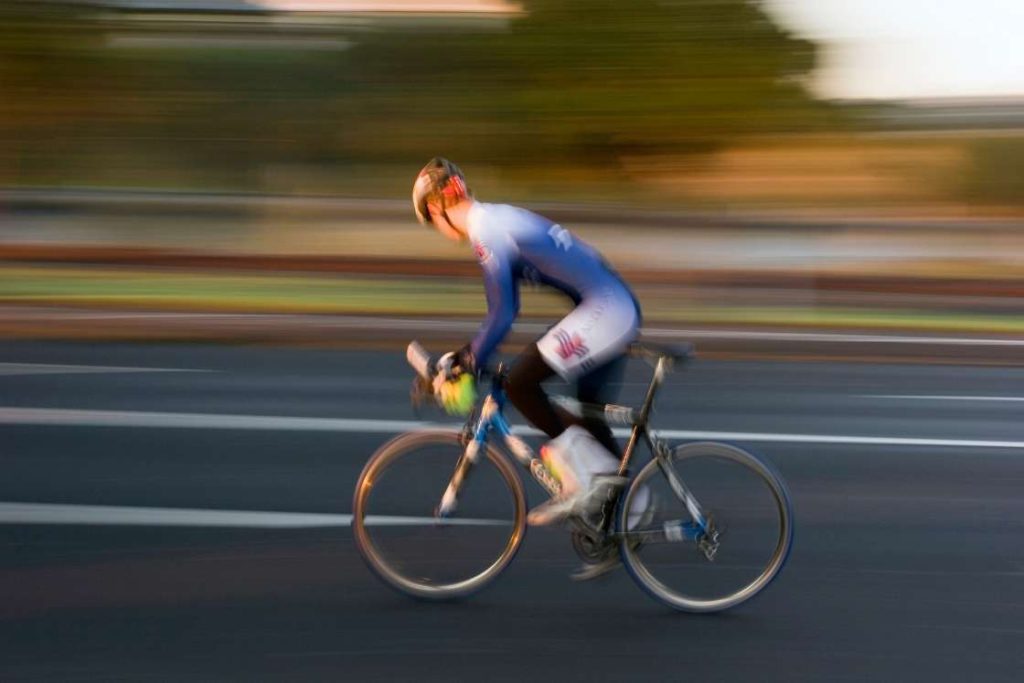
Your power is the amount of potential energy your muscles can store, and your speed is how fast you can convert that potential energy to kinetic energy. Thus when you add flexibility to your power, you get speed. And acquiring flexibility for cyclists is an iconic benefit of yoga.
In cycling, flexible bones and muscles will swiftly make bigger movements (increased speed), converting potential energy to kinetic, in no time. What is flexibility? Flexibility is the ability of your muscles and joints to stretch in different directions, with comfort.
The easiest way to achieve flexibility for cycling is to practice stretching exercises. And yoga has a stretch for almost every muscle and bone. Yoga stretches will greatly increase the flexibility in your knee joint, hip joint, shoulders, ankle, lower back, and spine. Additionally, yoga helps you utilize every last bit of tissue in each muscle.
With complete activation of your muscles, your joints get better support, as such, more flexibility. Yoga exercise will increase the efficiency of your abdomen muscles, lower back muscles, muscles connecting your ribs, hamstrings, glute, and calf muscles.
These 3 yoga poses will help you improve flexibility which in turn increase your cycling speed.
1. Cat-Cow Stretch
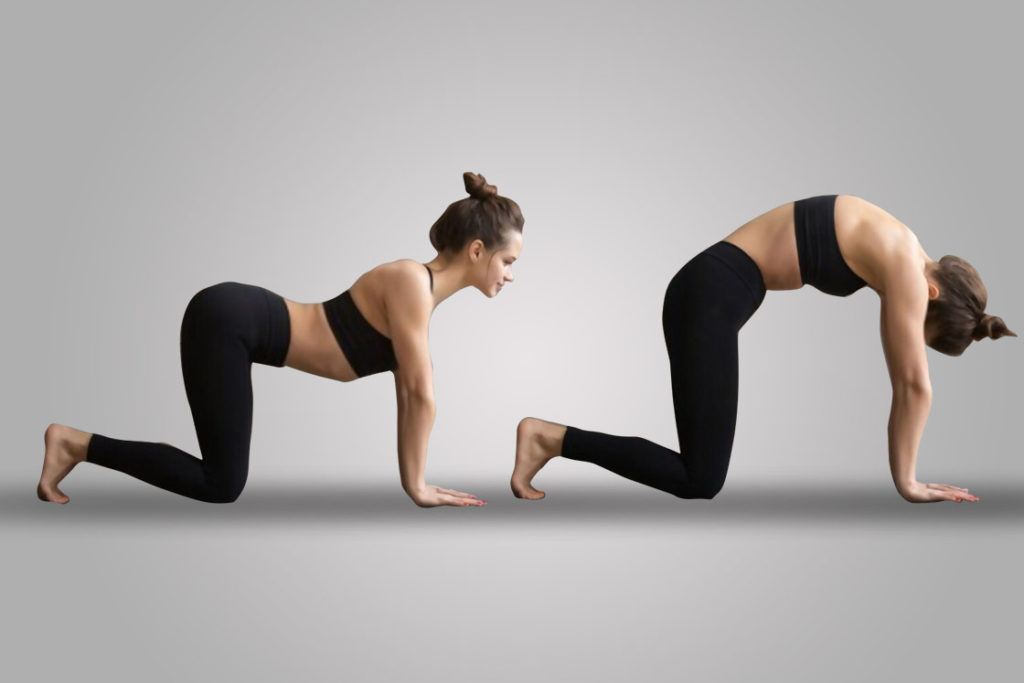
As a cyclist, your spine goes through immense stress, and Cat-Cow is just the pose to take care of it. Many yoga poses stretch your spine, but very few does the dual stretch of Cat-Cow. This pose bends your spine successively in back and forth arches, which preps your body for a wider range of movements.
- Get down on all four, with your wrists below your shoulders and knees under your hips.
- With an inhale, drop down your belly, roll back your shoulders and look up.
- With an exhale curl up, by sucking your belly up against your spine, and looking down.
- Do this pose for 10 repetitions
The cat-Cow pose seems very simple, and it normally is, except for the body awareness it requires. The truly dropping down of your belly and curling up against your spine can be a tricky thing if you cannot consciously visualize your movements. In such a case, try this pose in Infront of a full-size mirror.
2. Pigeon Pose (Kapotasana)
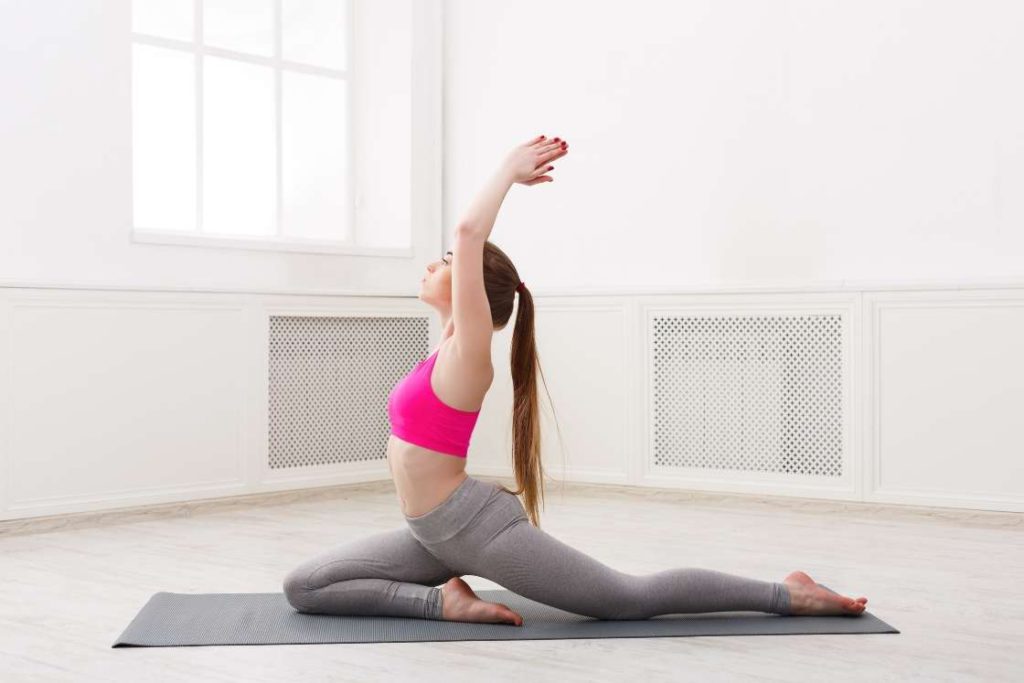
A cyclist’s legs are always the primary point of focus, especially when it comes to speed. And the pigeon pose will help you increase the overall flexibility of your legs.
The pigeon pose simultaneously includes stretch, twist, and bend of your leg muscles, making them versatile in performance. The pose is also quite adept in enhancing blood circulation, which can further increase stamina.
- Start from downward facing dog.
- Take your left leg, bend it from your knee, fold it and place it behind your left wrist. Your left foot will be behind the right wrist.
- Sit down in a stretch allowing your right leg to extend behind. Rest the top of right foot, against the ground.
- This stretch should open up really deep into your hips.
- Now with your hands make a support Infront of you, and bend forward and rest your head on your hands.
- You can use a yoga block as well.
- Hold the pose for 10 breaths.
- Repeat with other leg
In this pose, If there is a lot of gap between your groins and the ground, use a folded blanket underneath as a support. Also make sure your left knee is outside the line of your hips and as your bend forward you are not forcing your bodyweight on your left knee.
3. Butterfly Pose with forward bend
The pedaling motion inflicts particular stress on your groin region, which can reduce speed after a while. Butterfly pose (baddha konasana) opens up your groin region for both strength building and injury healing. The normal butterfly pose works as well, but the forward seated variant is better suited for cyclists. The forward seated variant increases the depth of the stretch in your groins.
- Sit in a staff pose position.
- Bend your knees and fold your legs to touch your soles together.
- Clasp your hands together around your feet, and pull them closer to your groin.
- Your legs should be in a butterfly formation.
- Your knees will tend to drop down all the way to the floor, but keep them just off the ground.
- Now holding your legs fixed on their position, bend your upper body forward and touch the ground with your forehead.
- Take 5 breaths before the forward bend and 5 breaths after the forward bend
Place a yoga block below each of your knees. The excess pull by your thighs on your groins, might cause groin injury. Also when bending down, gradually extend the bend. It is not compulsory to touch the ground at one attempt. Slowly feel how the bend feels to your body, and accordingly, proceed.
Yoga for cycling Stamina
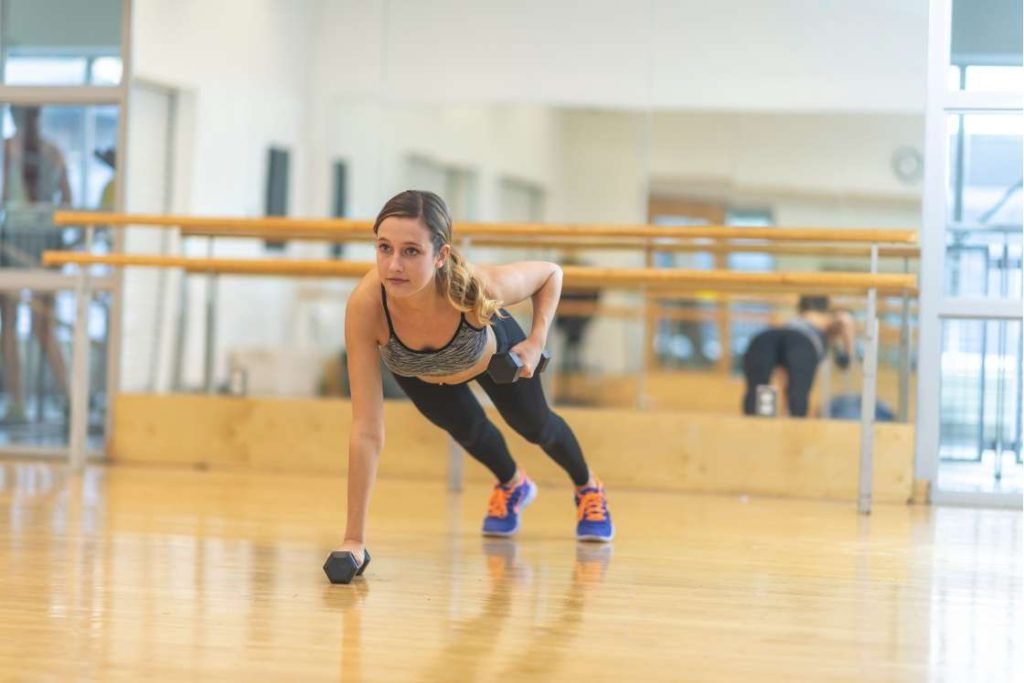
Your stamina is the ability to sustain prolonged tension in your muscles and bones, without getting injured. This means well-nourished and oxygenated tissues. Your stamina is also determined by your overall health.
Yoga poses and practices will enhance the blood circulation in your body, which will provide nutrients rich blood to every organ, bone, and muscle in your body. Practicing yoga poses prior to cycling can increase your stamina to a great extent.
Pranayama breathing exercises practiced in yoga, are an advanced benefactor of your respiratory system. Yoga helps you inhale deep breaths, and function better in the oxygenation of your blood.
Yoga will also help you keep your heart rate in control, amidst the adrenaline rush of cycling. A well-balanced heart rate will be critical to cyclists’ stamina, found in a 2013 research study.
These 3 yoga poses will help you increase stamina for cycling.
1. Downward facing dog (Adho mukha svanasana)
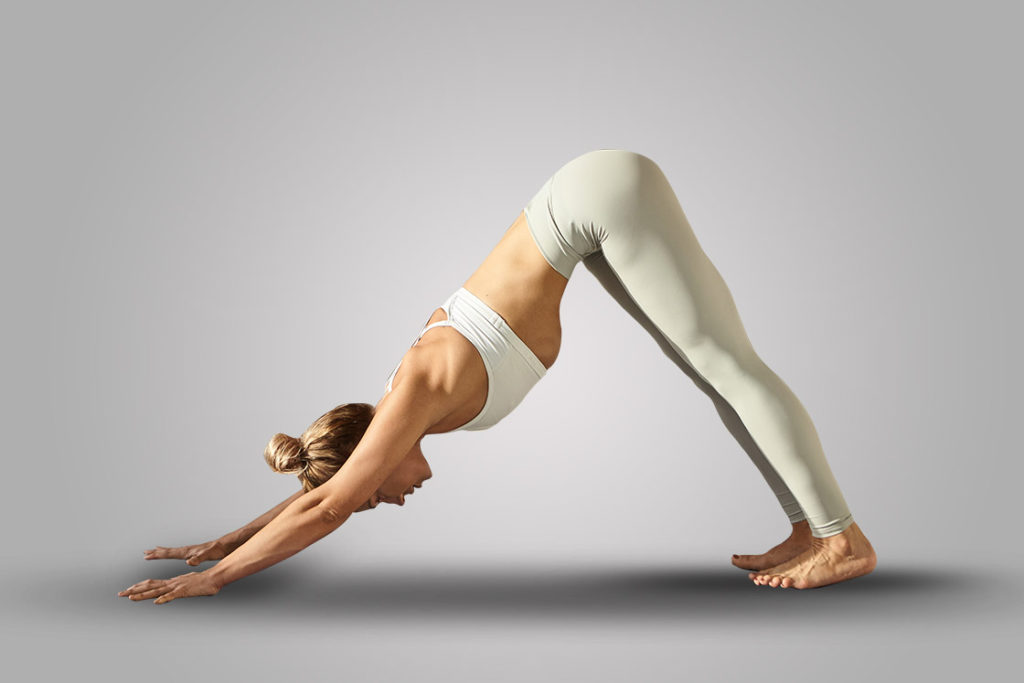
The downward-facing dog is a pose that benefits a number of organs in your body. Downward facing dog enhances your cardiovascular, respiratory, and abdominal functions.
The pose also stimulates your lymphatic system to detoxify your body. Downward facing dog boosts your circulatory system as well. Lastly, this versatile pose increases the flexibility of your overall body mass.
- Get down on all fours.
- Your wrists should be under your shoulders, and your knees exactly below your hips.
- Keep your legs hip length apart.
- Lift your knees and Straighten your legs.
- Now push with your hands against the ground, and stretch your upper body, as you push your buttocks upward and backward.
- Place your heels on the ground.
- Hold your pose for 5-10 breaths and release
Touching your heels to the ground can be a difficult task. So don’t force yourself, that could hurt your knees, or pull or calf muscles. Just remember to stretch the upper body, push back and up your buttocks, and not break your knees. Keeping these three elements correct, you can cheat by remaining on your toes
2. Warrior II Pose

Warrior II pose enhances your blood circulation, which enables your overall well-being. This pose increases the stamina of your hamstrings, glutes, upper back and shoulders. Warrior II enhances your nerve functions, which help you gain better control over your movements and postures
- Stand straight with your legs wide apart. Maintain a gap of 3 feet.
- Raise your hands horizontally at the sides of your body.
- Turn your left foot 90 degrees to your left and your right foot about 45 degrees to your left.
- Bend your left knee, let your right leg stretch out, and push your weight to your left.
- Your body should be lowered, and move towards your left.
- However, do not entirely lean on your left leg, try to keep your body as centered as possible.
- Your left leg will carry tension of weight, whilst your right leg will stretch.
- Look towards your left.
- In the final position your right lower leg should be at 90 degrees to the ground, whereas your bottom thigh muscles in your right leg should be parallel to the ground.
- Take 10 breaths and repeat the pose on the other side.
You can play around with your hands and head, by bringing a bit of movement to them. As you hold your pose and breathe, look up and raise both your hands straight overhead. Once again, breathe, and look in front and bring your hands down to straight stretching Infront. And finally once again, breathe and look to your left and return your hands to your I initial position. This hand movement will enhance the blood circulation.
3. Eagle Pose (Garudasana)
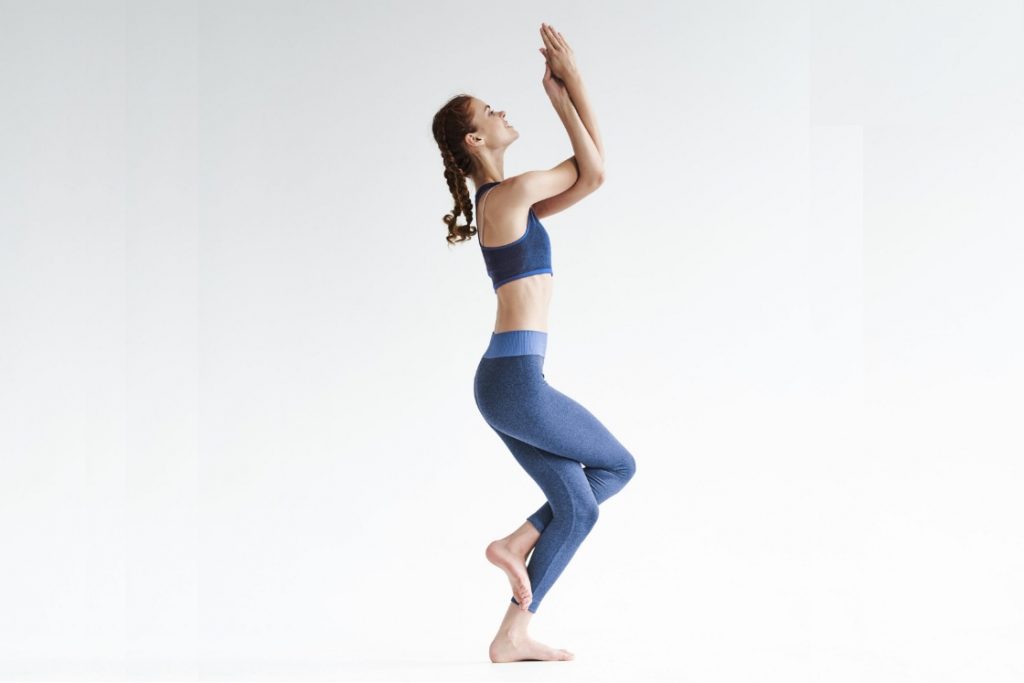
Eagle pose brings stability and balance to your muscles. It helps you become more aware of balancing your weight, which will come in very handy to a cyclist. The eagle pose apart from stretching your muscles for flexibility also augments your nervous and circulatory systems.
- Stand in mountain pose.
- Raise your hands straight Infront of you.
- Get down on chair pose.
- Lift your right leg, wrap it over and around your left knee, and hook your right foot behind your left calf muscles.
- Bend your hands at your elbows.
- Take your left elbow under your right elbow, and bring back your left palm over your right palm.
- Hold your pose for 10 breaths and switch the hand and leg roles.
Balancing is going to be a major issue with this pose. So initially try the leg pose with hands straight Infront. Once the leg balance settles get the hand posture in place.
Conclusion
Cycling itself is an excellent cardio and exercise. However, it is a very intensive exercise, causing a lot of wear and tear to your mind and body.
Yoga apart from building your power, speed and stamina will also give you the much-needed rest. Almost every yoga pose has a unique rest element to it. Thus when approaching yoga practices, try to concentrate and tap into the vast restorative nature of yoga.
